
How
does Satellite
Radio work?
|
How Satellite Radio works?
|
Satellite Radio
How does it work?
|
|
Satellite
Radio Receivers
Satellite Radio beams the signal up to a satellite, and overcome
the limitations of ground-based
transmitters
|
Satellite Radio - Basic Concept
|
Satellite radio is
such a remarkably simple concept that one might wonder why it took until
2001 for the first space-based audio service to make its debut in the
United States.
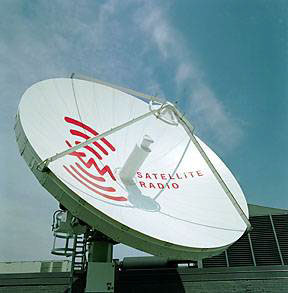 |
At least itís
simple on the surface: Take a music, news or talk station, beam the signal
up to a satellite, and overcome the limitations of ground-based
transmitters whose signals generally drop off as distance increases. Then
make sure the programming is more appealing than traditional radio
stations and cut down on the number of commercials in exchange for a
monthly subscription fee.
But as it turns out,
satellite radio is a whole lot more complex than it seems on paper Ė and
it took cutting-edge technology to make the systems operated by Sirius
Satellite Radio and XM Satellite Radio work.
XM and Sirius are
not the first companies to enter the satellite radio industry: Worldspace
Corp., a firm based in Washington, has provided satellite radio in Asia,
Africa and Europe since 1998. But Worldspace was intended primarily for use in |
| One
of XM's two seven-meter uplink satellite dishes located at the
company's headquarters. |
fixed locations, while the systems used by XM and Sirius are optimized to
reach U.S. listeners on the go.
|
|
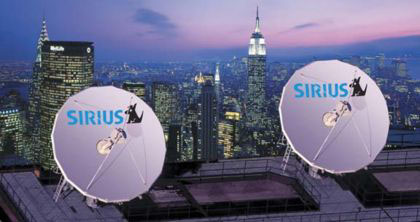
Sirius uplinks
its signal from New Jersey, with backup
dishes in Manhattan (above).
|
It took a number of
years to develop the XM and Sirius systems.
Engineers had to
figure out how to squeeze dozens of individual channels into a relatively
small amount of bandwidth and come up with reliable methods of beaming
signals from thousands of miles in space to roving antennas smaller than
tennis balls.
They also had to
develop inexpensive circuitry, or chipsets, to enable receivers to decode
the satellite signals, which are encrypted to prevent reception by
non-subscribers. Both firms are working on newer versions of their
chipsets that will be smaller and use less power.
Sirius and XM each
took somewhat different approaches, although the end result, from a lay
personís perspective, is the same: 100 channels of music, news, sports
and other fare available virtually anywhere in the continental United
States. The companies are trying to distinguish themselves with
programming and attitude.
XMís system uses
two very powerful satellites floating in space directly above the equator.
The spacecraft are in geostationary orbit -- they appear from the ground
to remain in fixed perches, because they move around the Earth at the same
speed the planet is rotating.
Geostationary
satellites are commonly used for all sorts of space-based communications
because they enable use of inexpensive, fixed antennas. Satellite TV and
Internet systems are two examples of consumer-oriented technologies that
use this type of satellite.
Repeat
that, please
Since geostationary
spacecraft are above the equator, terminals on the ground must have a
decent view of the southern sky to receive signals from them. This posed a
challenge for XM, since listeners in cars often pass by obstacles, such as
buildings, foliage or hills, which can block geostationary satellite
signals.
XMís solution is a
network of repeaters Ė antennas on buildings and other sites that
receive satellite signals from an optimally placed antenna and retransmit
them. The repeaters are located primarily in built-up areas, where loss of
the satellite signal is most likely to occur.
Each XM receiver is
equipped to receive signals from both of the companyís Boeing 702
satellites and a repeater simultaneously. As long as one of the sources is
available, the radio will play without interruption. In addition, the
receivers have buffers that store programming for several seconds,
allowing operation to continue even if no signal is available momentarily.
Sirius uses a trio
of Loral FS1300 satellites in unique elliptical orbits in an effort to
avoid the problems posed by geostationary satellites.
The orbits, shaped
like figure eights, allow the satellites to appear higher in the sky than
XMís, cutting down on the potential for a listener to be out of range of
a satellite signal -- and allowing Sirius to have a much smaller number of
repeaters.
Siriusí repeater
network also avoids the need for specialized antennas that can track the
companyís non-geostationary satellites as they move about the sky,
Sirius feeds its repeaters using capacity on a geostationary satellite
leased from a traditional satellite operator. Listeners canít tell that
the signals they receive via the repeaters do not
travel over Siriusí fleet of satellites.
The Sirius
satellites each spend about 16 hours over the United States, then whip
around the other side of the Earth and return eight hours later for
another stint hovering over Siriusí listening area, according to Ted
Hessler, the companyís vice president of space segment and enterprise
operations.
Two Sirius
spacecraft cover the United States at any given time, Hessler said.
In
the studio
XM and Sirius both
operate digital broadcast centers that combine dozens of individual
recording studios with huge amounts of storage to hold hundreds of
thousands of compact discs worth of music in digital format.
|
 1.
Sirius and XM both produce live and taped programming,
ranging broadly from Alanis Morissette, right, to sports and
news. 1.
Sirius and XM both produce live and taped programming,
ranging broadly from Alanis Morissette, right, to sports and
news.
|
Programmers just
point and click at the material they want to play, and it airs directly
from the storage system at the appointed time. During transmission, the
system also adds a short description of the music or other material for
display on a small receiver screen. That
is one unique advantage to satellite radio -- you can find out the artist
and song title as each piece of music plays.
The 22 terabytes of
storage capacity at XMís facilities in Washington can hold about 250,000
CDs, said Anthony J. Masiello, XMís senior vice president of operations.
Terry Smith, senior
vice president and chief technology officer of Sirius, said his
companyís studios in mid-town Manhattan have about seven terabytes of
storage. While that is less than XM has, Smith says itís plenty.
"Our library is
constantly being refreshed as new content comes in," Smith said.
Both companies also
maintain large collections of CDs to augment their digital libraries. They
also retransmit programming that originates elsewhere, such as news,
sports and comedy channels, and maintain studios where artists perform
live.
Another, less
visible key to satellite radio is digital compression, a technique to use
radio spectrum as efficiently as possible. Both satellite radio
broadcasters use sophisticated algorithms to squeeze as much material as
they can into the available bandwidth without causing audio quality to
degrade.
XM and Sirius are
each allocated 12.5 megahertz of radio spectrum by the U.S. Federal
Communications Commission.
Satellite Radio is
looking far beyond the dashboard.
Satellite radio has turned the corner.
First positioned as a mobile
entertainment service for long-distance truckers and road
warriors, pay radio is now heading home, to the park, and anywhere
else people want to listen to
music. Thanks to the recent success of Delphi's SKYFi, a
portable amplifier/speaker
shell with a slot for an XM Satellite Radio receiver module, XM--and
its competitor, Sirius--are looking far beyond the dashboard.
The Delphi SKYFi--at a street price of $99
for the boombox with amplifiers and
speakers, and $99 for the receiver module
|
|
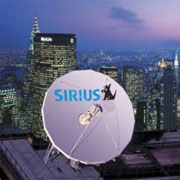
2. The programming is beamed to satellites from dishes
operated by satellite radio operator.
|
|
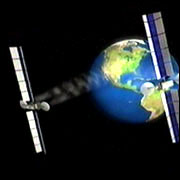 3.
The satellites broadcast the signal back to Earth, where
it's picked up directly by receiver units. The signal is
also received and rebroadcast by repeater stations in
metropolitan areas. XM uses two geostationary satellites
(right) that remain constantly above the United States.
Sirius uses three satellites, two of which are always over
the country. 3.
The satellites broadcast the signal back to Earth, where
it's picked up directly by receiver units. The signal is
also received and rebroadcast by repeater stations in
metropolitan areas. XM uses two geostationary satellites
(right) that remain constantly above the United States.
Sirius uses three satellites, two of which are always over
the country.
|
|
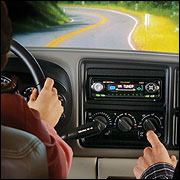 4. A receiver buffers the broadcast for a few seconds,
so if it loses the satellite signal it can use one from a
repeater station, helping insure a continuous broadcast.
Overpasses and tall building are particular problems.
4. A receiver buffers the broadcast for a few seconds,
so if it loses the satellite signal it can use one from a
repeater station, helping insure a continuous broadcast.
Overpasses and tall building are particular problems.
|
itself--breaks
the $200 price barrier. That appears to have caught the attention
of cost-conscious consumers who also have to pony up $9.99 per
month for XM Radio service.
Sony's home unit cost $300 to $350 when it was introduced
in 2001. In 2002, Sony stopped producing the home unit when it
decided not to continue the line.
|